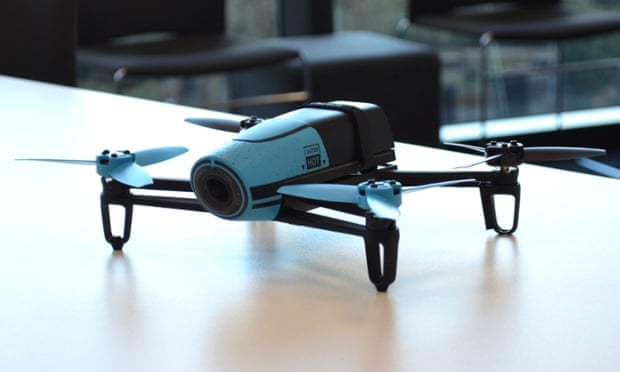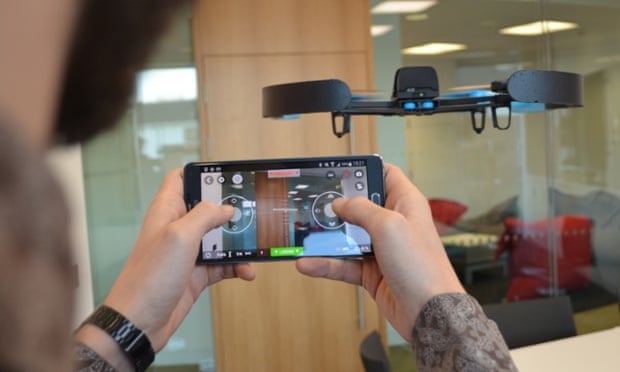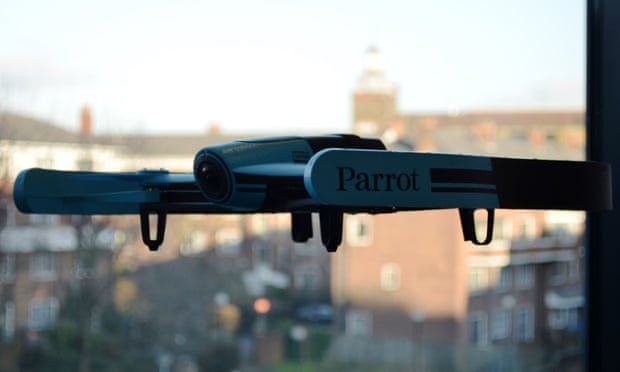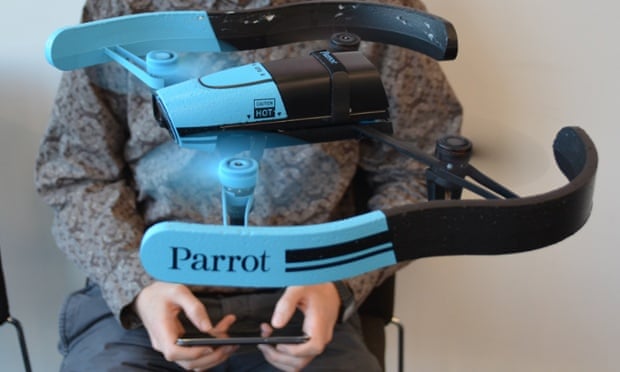Parrot’s latest Bebop drone the prosumer camera drone you’ve always wanted. Photograph: Samuel Gibbs for the Guardian
The Parrot Bebop is a camera drone with a real focus on recording video and some seriously impressive image stabilisation. It is Parrot’s third generation full-sized flying quatrocopter and is aiming to fly into a sweet spot in the market.
The device is a half-way house between a drone designed for carrying a large camera, such as those often used in TV shows like Top Gear and the toy drones intended to entertain. A “prosumer drone”, it lands at the fun end of the scale, very much for those looking to make home movies rather than television documentaries, but that’s no bad thing.
Lightweight but strong
The new drone from Parrot, the French Bluetooth specialist, looks like almost any other quadrocopter. It has four exposed propellers on four extended arms that surround a tube-like body. The arms attach to an under plate, which supports a polystyrene body containing the camera and a tray for the battery on rubber buffers that help neutralise vibration.
For indoor flight there are two 10g clip-on polystyrene shells that are designed to protect the drone from walls - and the walls from the drone.
They attach easily but a couple of crashes left marks on the wall and chunks cut out of the shells by the blades. The drone kept working just fine, though, even with a near full speed head-on collision with the wall.
The Bebop also comes with a full spare set of propellers that are very easy to swap for broken ones, should the worst happen.

Specifications
- Size: 330 x 380 x 36mm with the shells attached
- Weight: 410g with the shells attached
- Flight time: 11 minutes
- Camera: 14-megapixel 180-degree fisheye lens, 3-axis digital stabilisation
- Video: 1080p at 30 frames per second
- Storage: 8GB
- Connectivity: Wi-Fi (2.4 and 5GHz) 250m range, microUSB, GPS/Glonass
Smartphone controls

The Bebop is available with a “Skycontroller” – two joysticks strapped to a frame for a tablet – but most are likely to buy the drone on its own and control it using Parrot’s free Freeflight 3 app on a smartphone or tablet.
The app works on iPhones, iPads, Androids or Windows Phones and connects to the drone using Wi-Fi to display a live feed from the camera. The drone broadcasts its own network, and once connected works at a range of up to 250m from the tablet or up to 2km from the Skycontroller.
There are three ways of directly controlling the Bebop using the app: tilt, virtual joysticks or tilt with independent camera control. The tilt control is fun as a toy, but difficult to use for any tight control. The virtual joysticks work well enough to fly it through an office without too much trouble – precision control is difficult on a touchscreen, however.
Users can also plot a route on a map for the drone to fly itself using the built-in GPS chip outdoors.
Stable flight
In flight the Bebop is stable and resists both knocks and the wind buffeting it, returning to its original position almost aggressively. It can fly up to 150m from the ground at up to 2.5m/s at a maximum of 2,500m above sea level.
Despite maintaining a stable vertical position, however, it failed to deal with the internal circulation of air in our tests. It would spin uncontrollably when flying over simple low airflow vents or desks and drift from side to side when attempting to fly over a stairwell.
Two batteries are included in the box with the Bebop, along with a separate charger. It will fly for about 10 to 12 minutes per battery. It is also quite loud and the downdraft is enough to blow papers and anything not weighed down all over the place while flying. You can forget sneaking up on anyone.
Smooth video
The drone has a 14-megapixel camera in the nose with a fisheye lens and a 180-degree field of view. It records 1080p video at 30 frames per second, uses digital stabilisation and can adjust the angle of the camera independently from the motion of the drone. The image captured is flat, despite the fisheye lens that normally distorts the picture.
The video is ultra-smooth, resembling the kind of motion seen in first-person video games. Even when banking hard with the drone the video is completely flat. The quality of the video is decent, akin to a mid-range action cam, but suffers from graining in poor lighting conditions such as those inside an office.
The law

Flying the drone outside makes it subject to the CAA’s flight restrictions. Photograph: Samuel Gibbs for the Guardian
What you do with a drone in your own home is pretty much your business, but the Civil Aviation Authority (CAA) has certain rules about what you can and cannot do with remotely controlled flying objects including drones.
The current legislation means that it is illegal to fly a drone within 50m of a building or a person and 150m of a built-up area. In addition, the maximum flight height is 400m and the drone has to remain in line of sight and within 500m of the pilot.
For commercial purposes, pilots must complete a training course and apply for a permit to fly the drone from the CAA.
Price
The Parrot Bebop drone is available in red, blue and yellow and costs £430 or £770 with the Skycontroller. Two batteries are included, with extra batteries £50 a pop. Spare parts for all of the components of the Bebop are available individually from Parrot.
Verdict

The bottom magnesium frame works as a heat sink for the drone and so gets really quite uncomfortably hot. Photograph: Samuel Gibbs for the Guardian
The Parrot Bebop is a fantastic toy that allows users to go beyond just flying it around and crashing into things and make interesting videos and take photos from a completely new perspective.
The flight time of about 10 minutes is long enough to do something meaningful and the 8GB storage is enough to record most of a flight.
Despite being super smooth, the video is not of professional quality, but is perfectly good enough for most consumers. The biggest issue are the restrictions on where you can fly a drone. It is still fun to fly around indoors, but the lack of precision control with a touchscreen leads to more crashes than you would like for a £400 machine.
Pros: super smooth video, easy to set up, robust enough to survive a crash, fun to fly, two batteries in the box, GPSCons: graining in low-light conditions, difficult to control precisely, legislation on drone use restrictive, expensive for a toy


No comments:
Post a Comment